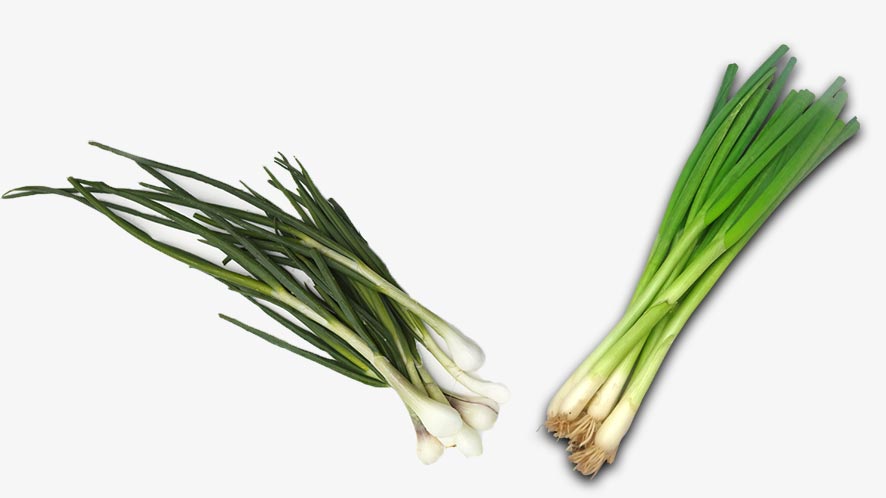Scallions Versus Green Onions – 6 Easy differences!
Scallions Versus Green Onions
If you are fond of cooking and trying out new recipes, you must have noticed different types of onions used in recipes of almost all cookbooks. While some may ask you to use green onions, others specifically instruct using scallions.
What’s more, some recipes even use shallots, chives, leeks, and spring onions for cooking up some of the best delicacies out there, that are loved and gorged by you. Now that you desire to try out a couple of them yourself, it would be handy to get the know-how of the ingredients, before you attempt dishing them out.
For starters, let’s begin with the difference between using scallions and green onions. Well, this is a debatable statement that doesn’t seem to conclude. Both belong to the genus Allium of the edible perennial plants but have subtle yet specific differences. Though they can be used as substitutes for one another in recipes, each has its own taste and flavor.
Scallion, itself, is a broad term that includes various types of onions, like green onions, young leeks, and scallions, while a green onion is used to describe a new onion harvested while its top is still green and the bulb still small. Read on further as we guide you toward identifying scallions and green onions and the differences between the two.
Scallions
The youngest or least mature of onions with extremely thin white bases which are no wider than their long, straight green stalks are called scallions. Their roots are white and stems are dark green and hollow. The white roots have not yet developed into an onion bulb. The mild flavor that they possess makes them a good substitute for chives while preparing a number of recipes. They can be consumed raw and cooked, but are mostly used raw in green salads and as toppings for sauces.
Green Onions
Interchangeably used for scallions, green onions are different from their cousins. The slightly matured scallions are called green onions. They are typified by their long, green, and delicate stalks affixed to small and very slender white bulbs. Even though they have a mild taste, they are out of their ‘green onion’ stage soon to take on the regular pungent flavor of fully grown onion bulbs. Just like scallions, green onions, too, are sliced or chopped raw for garnishing green salads, pasta savories, and baked potatoes. They are also known as bunching onions. While the Americans call them green onions, Australia and England refer to them as spring onions.
Scallions Versus Green Onions
- Pick up a green onion and you’ll notice a white root with green leaves, wherein the white root is just beginning to form a bulb shape. As such, a green onion has a bulb-shaped root or is rounded. Conversely, a scallion is characterized by a square root, with only a hint of bulb forming. In short, a scallion is an immature green onion.
- Both the green tops and white bottoms of scallions are edible and most often used in preparing salads and garnishing various sauces. Green onions, on the other hand, are not edible raw and hence, not very flavorsome. However, they make great colorful toppings for vegetable salads, sauces, and baked potatoes, when chopped.
- Talking about flavor, scallions provide a milder taste than green onions, which have a flavor similar to onions, contrast.
- Due to the mild flavor, the scallions can be eaten raw or cooked. However, the leaves of green onions give off an unpleasant taste which makes them inedible. Thus, the bulbs of green onions should be cooked before consumption.
- Green onions are matured spring onions, with a distinct flavor and taste of full-grown onions. On the other hand, scallions are completely immature green onions, defined by a really vague rounded shape and stronger flavor, compared to chives.
- You can use green onions in place of scallions but not scallions in place of green onions. Scallions can be used in place of chives.
With the above difference between scallions and green onions, the debate must have been solved to some extent. Now that you are clear with the above info about scallions versus green onions, it’s time to get geared up for cooking a delicious dish!

Deciphering Scallions and Green Onions in the Culinary World
Understanding the Nuances
When delving into the realm of cooking, the choice between scallions and green onions can be a source of culinary confusion. The culinary landscape is vast, with various onion varieties like shallots, chives, leeks, and spring onions adding depth to recipes. As you embark on your culinary journey, gaining a comprehensive understanding of these ingredients becomes crucial for crafting delectable dishes.
Unraveling the Distinctions
The debate surrounding scallions and green onions is ongoing, with both belonging to the Allium genus but exhibiting subtle differences. While these ingredients can be interchangeable in some recipes, it is essential to recognize their distinct tastes and flavors. Scallions serve as an umbrella term encompassing green onions, young leeks, and scallions themselves. On the other hand, green onions specifically refer to newly harvested onions with green tops and small bulbs.
Spotlight on Scallions
Scallions, the youngest among onions, boast thin white bases and long, straight green stalks. Unlike green onions, scallions have not matured into bulbs, offering a mild flavor ideal for substituting chives in various recipes. Their versatility shines as they can be enjoyed raw in salads or cooked, elevating the taste of sauces and garnishes.
Green Onions Unveiled
Slightly more mature than scallions, green onions feature delicate stalks attached to slender white bulbs. While possessing a mild taste, green onions soon transition to a pungent flavor as they mature further. Renowned as bunching onions, they are commonly sliced or chopped for garnishing salads, pasta dishes, and baked potatoes. Noteworthy is the distinction in nomenclature, with Americans using “green onions” and Australians and Britons favoring the term “spring onions.”
Decoding the Visual and Flavorful Differences
Examining the physical characteristics, a green onion sports a bulb-shaped root, while a scallion exhibits a square root with a hint of bulb formation. The edible parts of scallions include both green tops and white bottoms, suitable for salads and sauces. In contrast, the leaves of green onions are inedible raw, necessitating cooking before consumption. The flavor spectrum also sets them apart, with scallions offering a milder taste compared to the more onion-like flavor of green onions.
Crucial Considerations in the Kitchen
When it comes to application in recipes, scallions prove more versatile, being interchangeable with chives. Green onions, while not edible raw, contribute vibrant toppings to salads and other dishes when chopped. The distinction becomes crucial in understanding that green onions are matured spring onions, distinct from the immature scallions with a more pronounced flavor.
Final Verdict: Solving the Culinary Conundrum
In the scallions versus green onions debate, a clearer understanding has emerged. Armed with the knowledge of their differences, you are now equipped to confidently navigate the world of cooking. As you embark on preparing your next culinary masterpiece, whether it’s a refreshing salad or a savory sauce, the nuanced choices between scallions and green onions will undoubtedly enhance your gastronomic experience. It’s time to don your chef’s hat and explore the endless possibilities these ingredients bring to your kitchen!
Cooking with Insight
The distinction between scallions and green onions unravels their unique qualities, offering culinary enthusiasts a deeper understanding of their applications. While these onions share resemblances, their distinct flavors, edible components, and culinary usage present opportunities for creative experimentation in the kitchen. Armed with this knowledge, embark on your culinary journey, elevating your dishes with the nuanced flavors of scallions and the robustness of green onions.
